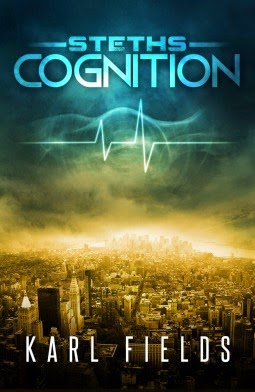How is human freedom really possible in the natural world as correctly described by modern physics, chemistry, biology, and cognitive neuroscience? Or, given the truth of modern science, are you really free? By 'real freedom,' I mean 'real free will and real rational agency'.
The post Are you really free? Yes: a new argument for freedom appeared first on OUPblog.
Once again, searching for unconventional computing methods as well as for a neurocomputational theory of cognition requires knowing what does and does not count as computing. A question that may appear of purely philosophical interest — which physical systems perform which computations — shows up at the cutting edge of computer technology as well as neuroscience.
The post The philosophical computer store appeared first on OUPblog.
Steths: Cognition is set in a near-future version of America where a select few truly are judge and jury, hearing cases and deciding on guilt or innocence, as well as punishment.
Devin Chambers is among a rare group of humans with a trait called hypersensitive tympanic syndrome: the ability to hear heartbeats and, more specifically, the emotions within them. All he wants to do is play football, but his abilities as a Steth attract the attention of the Faulkner Academy, a prestigious boarding school. That’s because, in addition to being a school for regular students, Faulkner operates a secret training facility, preparing young Steths for the day they will sit in judgment of others.
Faulkner students are treated like royalty. The dorms have more in common with a five-star hotel, and the cafeteria features linens tablecloths and servers. It’s heady stuff for a guy who comes from a neighborhood where “the primary color is concrete,” and choosing the Faulkner lifestyle should be a no-brainer. But Devin is conflicted, especially when he hears innocence in a death row inmate’s heartbeat, a sentiment no one around him shares.
Each decision Devin makes presents him with another dilemma instead of a resolution until finally, whether the condemned man lives or dies resides with him. At one point, Devin’s stepfather, Marcus, enters the kitchen to find Devin helping himself to a frozen waffle and peanut butter. Marcus points out that this has been “thinking food” for as long as he’s known Devin.
Without giving up specifics (discussion of the Steth training program with anyone not in the program is forbidden), Devin confides in Marcus, and the two have a heart-to-heart over store-bought waffles. It's a far cry from the gourmet fare served up at Faulkner and a key moment in the story, as the stakes have grown incredibly and Devin's actions will have serious implications.
Many of us have a “go-to” food when something has us stressed or sad or anxious. By having this scene play out at the breakfast nook, I thought helped make Devin relatable at a key moment. Also, I was trying to show that despite everything that he’s experienced at the academy, he hasn’t lost who he really is.
Thanks for stopping by to share your food for thought, Karl!
You can find Karl here:
By Susan Gathercole

Andy Calder (1965–2013)
Andy Calder, dearly loved by his family and his many friends and colleagues from all over the world, died unexpectedly on 29 October 2013. Born in Edinburgh in 1965, he was a loving brother to his sisters Kath and Clare and brothers-in-law Gary and Tony, and a devoted uncle to his nieces and nephews.
Andy was known internationally as a leading cognitive neuroscientist. He was a deep thinker, a meticulous experimenter, and an inspiration for those who worked alongside him. His ground-breaking research led to major new insights into vital social abilities, such as how we recognise faces, and how the brain processes and distinguishes between emotions.
After completing a PhD at Durham, Andy joined the MRC Cognition and Brain Sciences Unit at Cambridge (then the Applied Psychology Unit) in 1993, becoming a programme leader in 2000. In addition to his dedicated team in Cambridge, Andy worked closely with many collaborators, bringing to each project excellence in methods and precision in scientific thinking. This led to new discoveries including the brain systems that underlie unusual social abilities in conduct disorder and autism.
The news of his untimely death is devastating for all that knew him. Not yet 50, Andy had a wonderful future as a scientist still ahead of him. His abilities to answer important fundamental questions using rigorous methods will continue to inspire his many collaborators and the broader field of social neuroscience. A passion for overseas exploration made Andy a great travelling companion and a keen guest in the laboratories of his dear friends and fellow scientists, including Gilli Rhodes and Colin Clifford in Australia.
Andy was wonderful company. He was an entertaining house guest with his family every Christmas, and took a keen interest in all his nieces and nephews Clark, Amy, Ava, Rebecca, Cameron, Tim and Eve as they were growing up. He had a passion for film and theatre, and every summer would make the trip home to take full advantage of the Edinburgh Festival. A gifted pianist and singer, Andy was a key figure in pantomimes and productions in Cambridge. He made many lasting friendships with colleagues, who were delighted by his warmth, lightness of spirit, and wit (see colleagues’ memories).
Andy will be held dearly in the hearts of the many that knew him. He is greatly missed, but his spirit, life and achievements will be celebrated for many years to come.
Susan Gathercole is Unit Director at the MRC Cognition and Brain Sciences Unit. This article originally appeared on The Psychologist.
Andy Calder was a leading social cognitive neuroscientist at the MRC Cognition and Brain Sciences Unit. He was the lead author on Oxford Handbook of Face Perception.
Subscribe to the OUPblog via email or RSS.
Subscribe to only psychology articles on the OUPblog via email or RSS.
Image credit: Image courtesy of Susan Gathercole.
The post Memories of Andy Calder appeared first on OUPblog.

Aniruddh D. Patel’s research focuses on how the brain processes music and language, especially what the similarities and differences between the two reveal about each  other and about the brain itself. Patel has served on the Executive Committee of the Society for Music Perception and Cognition and is currently the Esther J. Burnham Senior Fellow at The Neurosciences Institute. Patel’s book, Music, Language, and the Brain, challenges the widespread belief that music and language are processed independently. This fabulous book won a Deem-Taylor Award From ASCAP and its ideas are explored in a PBS special The Music Instinct which airs tonight. Below learn about Patel’s experience with Snowball, the dancing Cockatoo.
other and about the brain itself. Patel has served on the Executive Committee of the Society for Music Perception and Cognition and is currently the Esther J. Burnham Senior Fellow at The Neurosciences Institute. Patel’s book, Music, Language, and the Brain, challenges the widespread belief that music and language are processed independently. This fabulous book won a Deem-Taylor Award From ASCAP and its ideas are explored in a PBS special The Music Instinct which airs tonight. Below learn about Patel’s experience with Snowball, the dancing Cockatoo.
Sometimes science takes you in strange directions. I study how human brains processes music, but last year I found myself in a living room in suburban Indiana, dancing with a sulphur-crested cockatoo named Snowball.
I had been captivated by his YouTube debut, where he seemed to really be dancing to the beat of human music.Click here to view the embedded video.
The ability to synchronize movements to a musical beat was long thought to be uniquely human, but Snowball’s dancing suggested otherwise. Fortunately I was able to collaborate with his owners and conduct a controlled study, showing that he really did sense a beat and move in time with it, even when no humans were dancing with him. Crucially, when we slowed down or sped up his favorite song (”Everybody”, by the Back Street Boys), he spontaneously adjusted his dance tempo accordingly, just as a human would.
Click here to view the embedded video.
This discovery (recently published in Current Biology) has implications for debates over the evolution of human music, and has opened my mind to the complexity of music perception by nonhuman animals.
Our work with Snowball appears in the PBS documentary “The Music Instinct“, which airs on June 24th.


Edward Wasserman earned his B.A. at UCLA and his Ph.D at Indiana University. He is now Stuit Professor of Experimental Psychology at the University of Iowa. Thomas R. Zentall earned his B.S. degree in psychology, his B.E.E in Electrical Engineering from Union College in 1963, and his Ph.D. from the University of California at Berkeley in 1969. He is now a Professor of Psychology at the University of Kentucky. Together they wrote Comparative Cognition: Experimental Explorations of Animal Intelligence. Below is an excerpt which looks at one reason why this research is so difficult.
Definitional and Observational Concerns
Few things set the animal world so dramatically apart from the rest of nature as does cognition–an animal’s ability to remember the past, to choose in the present, and to plan for the future. To the best of our knowledge, the human and nonhuman animals on our planet are the only living beings that evidence cognition. (The continually controversial case of cognition and the inanimate digital computer will not concern us here; see Blakemore & Greenfield, 1987, for a discussion of this issue.)
Despite the remarkable capacity, intricacy, and flexibility of adaptive behavior, cognition is not a magical or supernatural power; it is the natural product of the biological activity of the brain…Elucidating the workings of the brain is undoubtedly one of the most daunting challenges ever undertaken by the human species. The current excitement that is being generated by discoveries in the field of neuroscience testifies to the importance of this matter.
Unlike the operation of other bodily systems (like respiration), whose activity is usually directly observed in the isolated responses of particular organs (like the lungs), cognition is usually indirectly evidenced through the diverse responses of many different effectors, generally the skeletal muscles (although emerging methods in neuroscience herald the advent of more direct measures of brain activity). Hence, a youngster may sing, hum, or whistle a tune; play it on a piano, xylophone, or trumpet; tap out its rhythm with a stick on a drum; or write out its score with a pen on a sheet of paper. All of these various behaviors divulge her musical knowledge… Therefore, although the core of cognition lies in the activity of the brain, we usually learn of cognition via the early comparative psychologist Romanes (1883/1977) dubbed “behavioral ambassadors” (Wasserman, 1984).
Unequivocal distinctions between cognition and simpler Pavlovian and instrumental learning processes, as well as other behavioral or physiological processes like reflex action, maturation, fatigue and motivation, are devilishly difficult to devise. There is often spirited disagreement among researchers on the merits of these distinctions, as when workers try to explain the occurrence and integration of elaborate behavior patterns like courtship rituals.
Many cognitive processes may be behaviorally indistinguishable from simpler learning processes. For example, one may learn and remember a telephone number, say 987-2468, by repeatedly saying the number aloud (i.e., learning by rote), considered by many theorists to represent a simple learning process. Alternatively, one may notice that the telephone number contains digit patters like the descending serial order 9-8-7 and the even-number sequence 2-4-6-8, a cognitive process. Unless clear evidence is provided that a more complex cognitive process has been used, C. Lloyd Morgan’s famous canon of parsimony obliges us to assume that is had not; we must then conclude that a simpler learning process can account for learning.
The challenge then is to identify flexible behavior that cannot be accounted for by simpler learning mechanisms. Thus, a cognitive process is one that does not merely result from the repetition of a behavior or from the repeated pairing of a stimulus with reinforcement. Cognitive processes often involve emergent (untrained) relations. Furthermore, because simple learning is assumed to generalize to physically similar stimuli or contexts, in order to qualify as a cognitive process, the emergent relations cannot involve stimuli or relations that are physically similar to those that were explicitly trained.
For example, if one wanted to show that pigeon had the concept of identity, then one might train a pigeon to match red and green hues (i.e., to select red rather than green when the initial stimulus is red, but to select green rather than red when the initial stimulus is green). If one later tested the pigeon with orange and teal stimuli and one found good transfer, then one could assume that the concept of identity had been demonstrated because orange is similar to red and teal is similar to green. On the other hand, if one tested the pigeons with stimuli (e.g., black-and-white shapes such as circle and square), then evidence of good transfer might suggest that an untrained relation had emerged (i.e., that hte concept of identity had been demonstrated…). Thus, the demonstration of cognitive behavior implies that simpler learning processes cannot account for the demonstrated actions.








